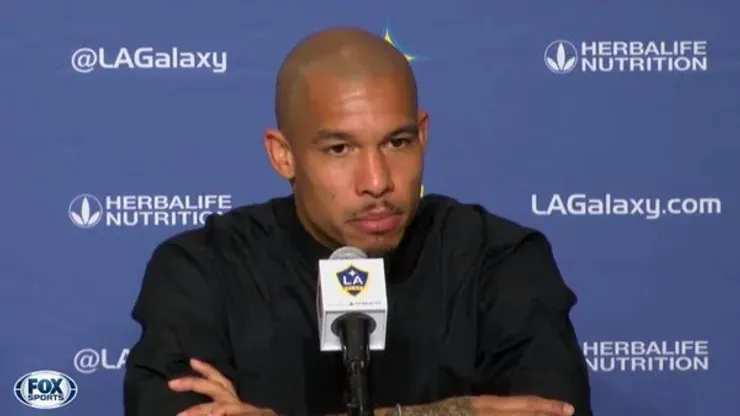The Nigel de Jong show at LA Galaxy lasted 18 appearances and ended as one of the more puzzling league departures in recent history. It is not all that surprising that a figure like De Jong would cause a stir, especially in the relatively small and shallow waters of MLS. However, in a rather distasteful and bizarre video montage send off complete with misrepresented stats and unflattering highlights, MLS manages to remind the soccer world just how young of league it really is.
The position of defensive midfielder is often times a misunderstood one. A thankless job where making connecting passes, covering space, and yes, putting in tackles doesn’t usually make the highlight reel nor the glamorous stat line alongside goals and assists. The defensive midfielder lives and breathes in an intangible zone. Sure, the occasional long distance chance is converted or a well placed pass finds the foot of an attacker and ends up in the back of the net, but those are rare occasions for a pure defensive midfielder.
Bruce Arena said it best when ask about a possible De Jong transfer at the time, “We don’t have an educated public to understand what he does, but he’s been an important member of our team.”
On the flipside, just as the occasional goal and assist occur, so does the mistimed or misplaced tackle. It is only a matter of time and comes with the territory, for a player who exists in this zone and is expected to provide defensive cover for marauding full backs and creative midfield players alike.
Nigel De Jong is a classic defensive midfielder. This should be a widely known fact.
So it is strange that MLS would focus on stats of misleading value. Citing zero goals and zero assists, but what of pass completion rate? One red card, three yellow cards, 20 fouls committed and one overblown and misguided three-game suspension in 1,561 minutes played is hardly off course for a defensive midfielder. A quick glance at the MLS stat page reveals that Gershon Koffie has played 1,261 minutes and has managed one red card, seven yellow cards and 32 fouls committed. In 1,923 minutes played, Marcelo Sarvas has racked up 1 red card, 11 yellow cards, and committed 59 fouls.
Koffie and Sarvas share two important traits with De Jong. One, they both play a similar position on the field as the Dutchman. And two, they are also foreign based players.
Foreign based players bring a different type of physical game to the league and MLS officiating is simply not developed enough yet to manage players of this level effectively. It should be no surprise when an MLS team struggles through CONCACAF Champions League and blames it on poor officiating.
MLS officials tend to let the game get out of control and attempt to regain control by pulling cards late or by pulling cards early in the game when a firm warning is necessary. This inconsistency leads to standards that are not necessarily shared by the rest of the officiating world.
Weak stat use and poor officiating aside, De Jong’s MLS tenure can more easily be summed up in what Koffie and Sarvas don’t share with De Jong: reputation and stature.
De Jong will likely carry the weight of 2010 with him wherever he plays. The infamous “karate kick” to Xabi Alonso’s chest during the 2010 World Cup Final against Spain, a tackle during a friendly between the U.S and the Netherlands that sidelined then American rising star, Stuart Holden and a tackle and subsequent leg break of Hatem Ben Arfa when De Jong played for Manchester City. It all occurred in one 12-month period that has come to define De Jong’s image as a player.
However, it is strange that other areas of his career are often glossed over. Over 130 appearances for Manchester City between 2009-13, 96 appearances with AC Milan between 2013-16, and 81 appearances for the Dutch National Team speak to De Jong’s quality as a player. No mere hack of a player makes that many high level appearances without bringing value to a team.
SEE MORE: Schedule of MLS games on US TV and streaming
More recently, De Jong’s willingness to take a pay cut to join MLS highlights his professionalism and interest in contributing to a league that still has a way to go in terms of quality of play. De Jong seemed to want to be in this for the long haul.
De Jong was set to become a designated player with the imminent departure of Steven Gerrard next season, but it seems as though MLS was just not ready to have Nigel De Jong become one of their marquee players. So perhaps this strange parting is what is best for both sides at this moment in time.
De Jong can ply his trade among fellow countryman Wesley Sneijder and work under his former coach Jan Olde Riekerink. MLS can focus on improving officiating, focus less on video montage shaming and hopefully grow up a bit more, so it can handle the pressures of a relationship with another dynamic and polarizing player in the near future.
200+ Channels With Sports & News
- Starting price: $33/mo. for fubo Latino Package
- Watch Premier League, Women’s World Cup, Euro 2024 & Gold Cup
The New Home of MLS
- Price: $14.99/mo. for MLS Season Pass
- Watch every MLS game including playoffs & Leagues Cup
Many Sports & ESPN Originals
- Price: $10.99/mo. (or get ESPN+, Hulu & Disney+ for $14.99/mo.)
- Features Bundesliga, LaLiga, Championship, & FA Cup
2,000+ soccer games per year
- Price: $5.99/mo
- Features Champions League, Serie A, Europa League & Brasileirāo
175 Premier League Games & PL TV
- Starting price: $5.99/mo. for Peacock Premium
- Watch 175 exclusive EPL games per season







